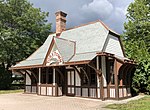Jefferson Valley, New York
Census-designated places in New York (state)Yorktown, New York

Jefferson Valley-Yorktown, commonly known as Jefferson Valley, is a census-designated place (CDP) located in the town of Yorktown in Westchester County, New York, United States. The population was 14,142 at the 2010 census. It is a hot spot for local shoppers, due to its Jefferson Valley Mall.
Excerpt from the Wikipedia article Jefferson Valley, New York (License: CC BY-SA 3.0, Authors, Images).Jefferson Valley, New York
Court Street,
Geographical coordinates (GPS) Address Nearby Places Show on map
Geographical coordinates (GPS)
| Latitude | Longitude |
|---|---|
| N 41.316944444444 ° | E -73.801666666667 ° |
Address
Court Street 3203
10598
New York, United States
Open on Google Maps






